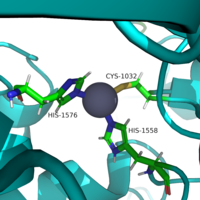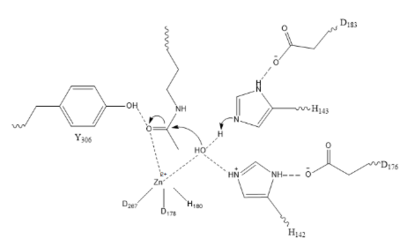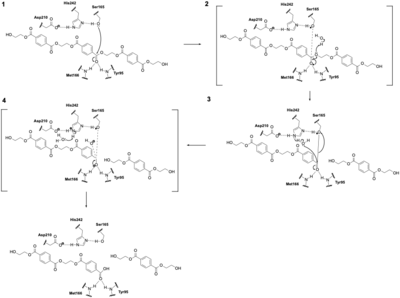User:Asif Hossain/Sandbox 1
From Proteopedia
| Line 29: | Line 29: | ||
At the rim of the active site, <scene name='81/811084/Asp101/5'>Asp101</scene> is involved in two hydrogen bonds between its own carbonyl Os and two consecutive amide Hs of incoming <scene name='81/811084/Ligand/7'>peptide-derived ligand</scene>. This forces the ligand to assume a cis-conformation. In addition, extensive interactions among many other polar atoms near the rim of the active site help keep the ligand lodged in the hydrophobic tunnel.** | At the rim of the active site, <scene name='81/811084/Asp101/5'>Asp101</scene> is involved in two hydrogen bonds between its own carbonyl Os and two consecutive amide Hs of incoming <scene name='81/811084/Ligand/7'>peptide-derived ligand</scene>. This forces the ligand to assume a cis-conformation. In addition, extensive interactions among many other polar atoms near the rim of the active site help keep the ligand lodged in the hydrophobic tunnel.** | ||
| - | ==Active site loop== | + | ===Active site loop=== |
<scene name='81/811087/Active_site_loop_1_s30-k36/4'>N-Terminus L1 loop</scene>(amino acid residues 30-36) lines a large portion of one face of the active site pocket and extends to the protein surface. This results in a larger surface opening of the active site pocket. It is suggested that this loop has high flexibility, making the active site pocket opening highly malleable and able to change to accommodate binding to a variety of different ligands. | <scene name='81/811087/Active_site_loop_1_s30-k36/4'>N-Terminus L1 loop</scene>(amino acid residues 30-36) lines a large portion of one face of the active site pocket and extends to the protein surface. This results in a larger surface opening of the active site pocket. It is suggested that this loop has high flexibility, making the active site pocket opening highly malleable and able to change to accommodate binding to a variety of different ligands. | ||
Revision as of 01:50, 8 April 2019
Contents |
Histone Deacetylase 8 (HDAC 8)
Introduction
Histone deacetylase 8 (HDAC8) is an enzyme that plays a role in controlling gene expression in Homo sapiens. Specifically, HDAC8 catalyzes the removal of an acetyl group off of the ε-amino-lysine sidechain of N-terminal core of histones. Histones consist of eight monomers to form an octomer complex. In addition, histones are highly basic and have a large positive charge. Since DNA is negatively charged, histones tightly interact with DNA. This prevents transcription factors from accessing DNA, thus decreasing gene expression. Chromatin remodeling by histone acetylation and/or deacetylation is an example of epigenetic regulation. HATs catalyze the addition of an acetyl group onto a histone. The hydrophobicity of the acetyl group prevents the interaction between DNA and histones. This allows transcription factors to access the DNA to increase gene expression. HDAC8 though reverses this reaction by catalyzing the removal of these acetyl groups by removing the acetate and the reclaimed positive charge on the lysine sidechain is able to interact with the negative charge on the DNA. As a result, DNA will bind more tightly to the histone protein, repressing transcription and gene expression.
| |||||||||||
Relevance
Besides controlling the gene regulation through deacetylation of histones, HDAC 8 also regulates the post-transcriptional acetylation status of many non-histone proteins, including transcription factors, chaperones, hormone receptors and signaling molecules. Thus, it has influences on protein stability, protein-protein interactions and protein-DNA interactions. HDAC 8 can therefore affect the regulation of cell proliferation and cell death. These processes are typically being altered in cancer cells and that makes HDAC enzymes an interesting potential target for cancer drugs. HDAC inhibitors have been shown to be promising cancer drug agents in prior research as the HDAC inhibitors cease tumor growth in cancer cells by either making them differentiate or undergo apoptosis. One way, the HDAC inhibitors ceases tumor growth is by the reactivation of the transcription factor, RUNX3, a known tumor suppressor. HDACi increases the acetylation of the protein and as the stability of RUNX3 is dependent on the acetylation status of the protein, the increased acetylation or HDAC inhibition will enhance the protein stability, causing an increase in the anti-tumorous properties of the protein. A number of HDAC inhibitors have been purified from natural sources or synthesized and HDAC inhibitors can be structurally grouped into at least four classes: hydrox-amates, cyclic peptides, aliphatic acids and ben-zamides. The Vorinostat(within the hydrox-amates class) has been FDA-approved for treatment of cancer. The hydrox-amate HDAC inhibitors inhibits the HDAC 8 by competition inhibition by making a favorable bidental interaction with the Zn2+ Ion and makes strong interactions with the Asp101.
References
1. Whitehead, L., Dobler, M. R., Radetich, B., Zhu, Y., Atadja, P. W., Claiborne, T., ... & Shao, W. (2011). Human HDAC isoform selectivity achieved via exploitation of the acetate release channel with structurally unique small molecule inhibitors. Bioorganic & medicinal chemistry, 19(15), 4626-4634.
Somoza, J. R., Skene, R. J., Katz, B. A., Mol, C., Ho, J. D., Jennings, A. J., ... & Tang, J. (2004). Structural snapshots of human HDAC8 provide insights into the class I histone deacetylases. Structure, 12(7), 1325-1334.



